I have provisionally labelled this essay as ‘the Elephant in the Room’ but I am conscious that this phrase has become somewhat overused. However, it does adequately describe my reaction to an Irish Times article entitled ‘Homeless figures reach record high with 14,429 people in emergency accommodation.’ What has piqued my interest in the article is, what wasn’t mentioned, hence my provisional title. The figures were released by the Department of Housing and related to those 10,028 adults and 4401 children in emergency accommodation in the week of July 22nd to 28th. You might be forgiven for thinking that the homeless figure was smaller than you had been led to believe. The article stated that this involved 2,086 families which could be easily managed within the Taoiseach’s promise of 250,000 houses over 5 years. (The Independent 07/04/24) Well not quite, as there are 6,573 single adults included in the numbers, it doesn’t give a breakdown by sex which would have been interesting. Let us assume that this means that we have to add the single adult number to the number of families to get the number of housing units required to solve the housing crisis. Well again not quite, as the numbers exclude the following:
None of this data includes homeless people who are in domestic refuges, those in direct provision centres who have leave to remain in the State, those who are sleeping rough, or the 2,539 male asylum seekers awaiting offers of accommodation. Irish Times 30/08/24
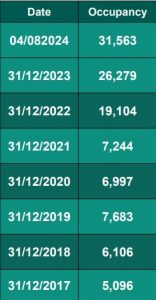
There doesn’t seem to be a holistic set of statistics for the homeless, which is surprising given the number of plans published by various parties to solve the problem. If we take the definition of homeless to mean all those who have no permanent accommodation, then we must add back those who have been excluded from the Department of Housing report. For example, as shown in fig 1 opposite, there are 31,563 people in direct provision managed by the International Protection Accommodation Services (IPAS). If we take the most recent weekly breakdown of those in direct provision (fig 2) as fairly representative, we can see that the housing requirement is not far short of the 30k figure in that all the groups shown in fig 2 will require separate housing units, with the exception of the children. I fully understand that this is a rough and ready
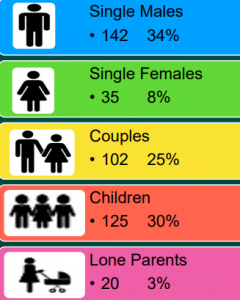
estimate but I don’t see any attempt by the IT to question the Department of Housings definition of homelessness. Why go down this particular rabbit hole? It is just to demonstrate that we need to question every statement made by government and media. There may be a reasonable explanation as to why homelessness is defined by one government department differently from the man or woman in the street. It is the job of the media to question and explain why that may be so.
The reaction to the report was predictable and the usual suspects were canvassed. Focus Ireland’s chief executive Pat Dennigan said ‘that family homelessness was continuing to rise mainly because families were finding it’ “harder than ever to secure a home and move out of homelessness”. ‘Labour leader Ivana Bacik described as “utterly heartbreaking” that thousands of children were “heading back to school” from emergency shelter.’ Catherine Kenny, chief executive of Dublin Simon, said as winter approached “the urgency of addressing the homeless crisis becomes even more pressing”. She continued: “An exponential increase in the development of new social housing … must be at the forefront of any Budget discussions.” (Irish Times 30/08/24) I am trying not to be disparaging about the above commentators but when I say the usual suspects they do tend to belong to a particular mindset who believe the only solution is government intervention and whose policy is mainly emotionally driven. However, there are those who I don’t mind disparaging and right on time we have the solution from Sinn Fein. They has seen the Taoiseach’s bid of 250k houses and have raised it to 300k with no impact on the exchequer. I will leave any analyse of their bid to those of us who believe that there is no such thing as a free lunch. Also, for those of us who remember the Celtic Tiger housing boom and the never ending saga of the Children’s Hospital, I am more than a bit sceptical about the governments ability to bring such a large project to fruition, in a timely, cost effective and efficient manner. What is the common theme from most of the above commentators is that we must increase supply by government subsidy, in one form or another. The Taoiseach says we need 250,000 units, Sinn Fein says 300,000, why not 500,000? These are just numbers thrown into the wind. Do we have the resources to do this and where are all these houses going to be built? We all remember the ‘ghost towns’ of the Celtic Tiger years. What we are not hearing is anything resembling a coherent plan.
And then we come to the Elephant in the room. When considering the shortage of any commodity we need to look at both sides of the supply and demand equation. John Ring, director of research at Savills, summarised the situation, as follows:
“While it is true that many countries across the world are facing housing shortages, it is important to recognise that the severity of Ireland’s is on a different level to others … Ireland has unique drivers – a delayed natural population boom, high migration due to strong economic growth, and structural legacy issues resulting from the Celtic Tiger crash – that explain why Ireland has the unenviable position having the worst supply-to-population growth [ratio] of the countries analysed.” (Irish Times, 15/08/24)
He might also have added government inactivity to the causes. If we look at the
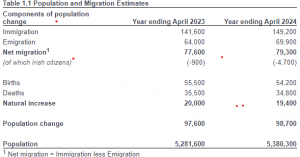
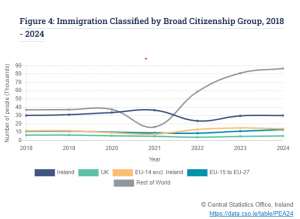
year ended April 2024 population estimates produced by the CSO (fig 3) we immediately see one of the most important elements fuelling the housing crises, mentioned by John Ring. The number we should look at is the top line which shows that there was an estimated 141k immigrants in the 12 months ending in April 2023 and 149k in 12 months ending April 2024. Now before anyone points out that we should subtract the emigration number to establish the net immigration figure, I would remind them that , in this instance, we are looking at housing demand and not population growth. In the CSO graph Fig 4: Immigration Classified by Broad Citizenship Group, 2018 – 2024, two things become obvious. The first is the exponential growth in immigration from 2021 and the second is the dominance of the ‘Rest of the World’ number. In the last two years that number was 86.8k for 2024 and 81.1K for 2023 but there was an outward flow, in this class, of 21.5k in 2024 and 14.4k in 2023 which can be offset.(CSO 27/08/24) The impact on housing demand of the other groups is fairly stable.
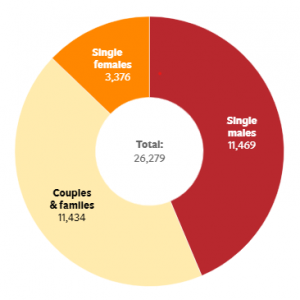
If we focus on the largest variable on the demand side of the equation we can also accept that not all of the net ‘Rest of the World’ numbers will require individual housing units. (86.6+81.1-21.5-14.4=132k) If we make another assumption and apply the proportions of single v family numbers in IPAS care in fig 5 to the two year net figure of the ‘Rest of the World’ immigration, we will get some idea of the real demand for housing. If we can extrapolate from fig 5 it would mean that single males make up 57.4k of the ‘Rest of the World’ total, single woman 16.9k and the remaining 57.7k is representing couples and families. If we want to gestimate how many units that makes, we can use the proportions in fig 2 to hazard a guess to breakdown the last category. Thus, if we take 3% of the family class and divide by 2, we get an approximation of the single parent number housing units. ( 3% x 57.7 /2= 0.87 units). If we then take the remaining number, assume 4 people per family (2022 Census records 1.34 children per family) we can have a view on what the ‘Rest of the World’ housing demand is. (3% x 57.7,/4 = 14k).
So, what is the final gestimate of housing for the biggest variable in the immigration numbers? Rest of the World net immigration 132k. Demand for accommodation based on that number, Single males 57.4k + single females 16.9k + single parents 0.9k + families 14k = 89.2k/2 = 44.6k units per year

I fully recognise that these are numbers held together by string and Sellotape; from disparate sources that don’t always line up and based on assumptions that are somewhat arbitrary. However, I couldn’t find a similar official breakdown, either from government sources or the media. I am sure that there is such a breakdown but to the ordinary citizen it is difficult to find. Up until 2021 Ireland had a housing problem, within three years it has become a housing crisis and the main reason for the change is immigration. To clarify, this essay is not about immigration, per se but about the absence of any honest discussion about the impact on the people and the plans to deal with what are foreseeable challenges. And that is the most frustrating part. The housing crisis is just one manifestation of this sudden change that is obvious to anyone with their wits about them. However the government and the media are operating under the rules of a form of omerta. Any discussion on housing should look at all the variables and instead of trying to label any contrary opinion as disinformation, should publish their own plans for the future and the data supporting them. As a random example, I read an article from the Irish Times editorial entitled, The Irish Times view on the housing crisis: further threats facing into 2023. Apparently, the only driver was the slowdown in building, nothing on the demand side changed it seems. In contrast, across the Atlantic/ Megan Specia sums up the current situation in an article entitled, ‘The Social Contract Has Been Completely Ruptured’: Ireland’s Housing Crisis’ (New York Times 15/01/24) I have discussed this issue in another essay (Dublin Riots ) and silence on one of the main reasons for the housing crisis is another manifestation of an increasing gulf between the citizens and government in Ireland. Finally, I was tempted to go with the New York Times heading but have stayed with the Elephant in the Room. It may be a bit hackneyed but it fits.
Sources
Kitty Holland, 30/08/24, Irish Times, Homeless figures reach record high with 14,429 people in emergency accommodation, https://www.irishtimes.com/ireland/social-affairs/2024/08/30/homeless-figures-reach-record-high-with-14429-people-in-emergency-accommodation/?utm_source=Newsletter&utm_medium=email&utm_content=Homeless figures reach record high with 14%2C429 people in emergency accommodation&utm_campaign=evening_update_digest
Ian Curran Jack Horgan-Jones, 18/08/24, Irish Times, Ireland’s housing crisis ‘on a different level’ with population growing at nearly four people for every new home built, https://www.irishtimes.com/business/economy/2024/08/15/housing-irelands-population-is-growing-at-nearly-four-people-for-every-new-home-built/
CSO, 27/08/24, Population and Migration Estimates, April 2024, https://www.cso.ie/en/releasesandpublications/ep/p-pme/populationandmigrationestimatesapril2024/keyfindings/